Must It Look Like the Picture Shown in the Lesson?
A mother who is using ArtAchieve art lessons recently wrote to ask if her child needed to make his drawing
-
Look exactly like the one in the art lesson’s guided drawing? Or
-
Could he draw it his own way?
The simple answer is that, of course, anyone is free to draw an ArtAchieve drawing your own way. However, it may be worthwhile
-
To remember why you are free to do so, and then
-
To notice the many interesting directions people have taken while using this liberty.
First of all, you probably remember the drawing rule that’s part of each lesson:
“Draw for yourself, not for your teacher (or me) or for anyone else.”
That’s an important rule.
The guided drawing that’s part of the lesson is there to provide as much support as possible for the child who needs that support. Lessons in Level I are especially prescriptive because we don’t want to have anyone at that level giving up because art is too frustratingly difficult.
I do this, of course, at the risk of frustrating kids who have courageous imaginations and are able to generate their own ideas. So if you or your child is ready to add his/her own twists on the details of the guided drawings, please encourage them to do so! Use what is useful in promoting their progress, and let the lesson serve as inspiration for their own ideas.
One of the goals of art education is to learn be bold enough to express ones own ideas. Art classes are a way of learning that each of us has our own good ideas; an art lesson is a time to help stretch that confidence.
Let me show you an example of some of the ways people have used ArtAchieve art lessons. It may inspire you to use the lessons as a springboard to develop your own ideas!
A group of adults and children recently sent me examples of their work that shows the range of directions a lesson might take.
For example, here is the image of the Dragonfly From Ecuador that appears on the website.
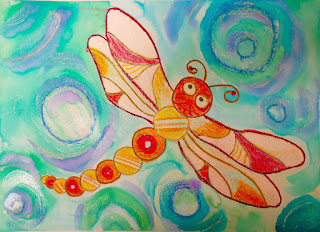
And here are some examples of student art work.
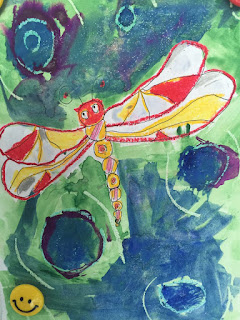
Notice how vibrant the watercolors became in this 8-year-old’s painting.
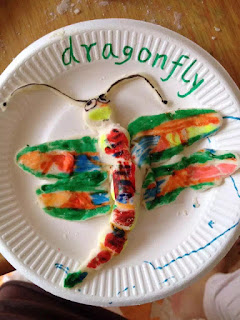
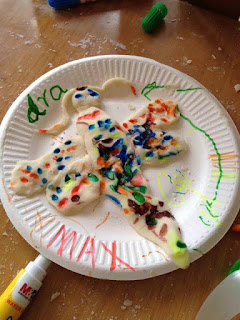
A mother and her 2-year-old child teamed up to make a 3-D version of the dragonfly.
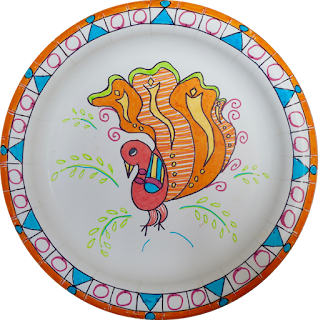
And here are some student versions.
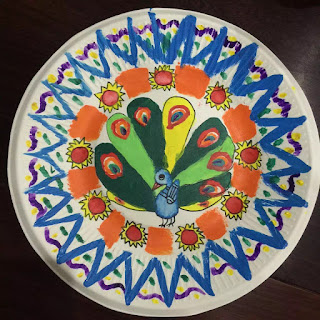
This 9-year-old used the dinner plate that is suggested in the art lesson
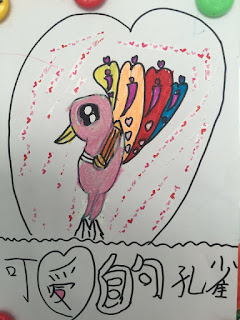
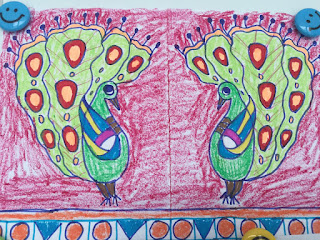
But these art students do not; they have chosen different media than the markers that are suggested in the lesson.
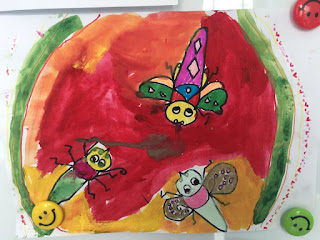
This 8-year-old used watercolors to paint The Hungarian Insects,

While an adult chose to use crayons, and to experiment with scale and color contrast
Last of all, here is a the website version of the Carpathian church in Level V.

And here is a student version of the same church.
Notice how much more energy the student's picture suggests than the original does - just because he made his own alterations on the guided drawing.

I hope you are inspired by these examples to experiment with your own art techniques.
Get started with some FREE ArtAchieve lessons here.
Use them as a springboard to develop your own ideas!
A mother who is using ArtAchieve art lessons recently wrote to ask if her child needed to make his drawing
-
Look exactly like the one in the art lesson’s guided drawing? Or
-
Could he draw it his own way?
The simple answer is that, of course, anyone is free to draw an ArtAchieve drawing your own way. However, it may be worthwhile
-
To remember why you are free to do so, and then
-
To notice the many interesting directions people have taken while using this liberty.
First of all, you probably remember the drawing rule that’s part of each lesson:
“Draw for yourself, not for your teacher (or me) or for anyone else.”
That’s an important rule.
The guided drawing that’s part of the lesson is there to provide as much support as possible for the child who needs that support. Lessons in Level I are especially prescriptive because we don’t want to have anyone at that level giving up because art is too frustratingly difficult.
I do this, of course, at the risk of frustrating kids who have courageous imaginations and are able to generate their own ideas. So if you or your child is ready to add his/her own twists on the details of the guided drawings, please encourage them to do so! Use what is useful in promoting their progress, and let the lesson serve as inspiration for their own ideas.
One of the goals of art education is to learn be bold enough to express ones own ideas. Art classes are a way of learning that each of us has our own good ideas; an art lesson is a time to help stretch that confidence.
Let me show you an example of some of the ways people have used ArtAchieve art lessons. It may inspire you to use the lessons as a springboard to develop your own ideas!
A group of adults and children recently sent me examples of their work that shows the range of directions a lesson might take.
For example, here is the image of the Dragonfly From Ecuador that appears on the website.

And here are some examples of student art work.

Notice how vibrant the watercolors became in this 8-year-old’s painting.


A mother and her 2-year-old child teamed up to make a 3-D version of the dragonfly.

And here are some student versions.

This 9-year-old used the dinner plate that is suggested in the art lesson


But these art students do not; they have chosen different media than the markers that are suggested in the lesson.

This 8-year-old used watercolors to paint The Hungarian Insects,

While an adult chose to use crayons, and to experiment with scale and color contrast
Last of all, here is a the website version of the Carpathian church in Level V.

And here is a student version of the same church.
Notice how much more energy the student's picture suggests than the original does - just because he made his own alterations on the guided drawing.

I hope you are inspired by these examples to experiment with your own art techniques.
Get started with some FREE ArtAchieve lessons here.
Use them as a springboard to develop your own ideas!
A mother who is using ArtAchieve art lessons recently wrote to ask if her child needed to make his drawing
-
Look exactly like the one in the art lesson’s guided drawing? Or
-
Could he draw it his own way?
The simple answer is that, of course, anyone is free to draw an ArtAchieve drawing your own way. However, it may be worthwhile
-
To remember why you are free to do so, and then
-
To notice the many interesting directions people have taken while using this liberty.
First of all, you probably remember the drawing rule that’s part of each lesson:
“Draw for yourself, not for your teacher (or me) or for anyone else.”
That’s an important rule.
The guided drawing that’s part of the lesson is there to provide as much support as possible for the child who needs that support. Lessons in Level I are especially prescriptive because we don’t want to have anyone at that level giving up because art is too frustratingly difficult.
I do this, of course, at the risk of frustrating kids who have courageous imaginations and are able to generate their own ideas. So if you or your child is ready to add his/her own twists on the details of the guided drawings, please encourage them to do so! Use what is useful in promoting their progress, and let the lesson serve as inspiration for their own ideas.
One of the goals of art education is to learn be bold enough to express ones own ideas. Art classes are a way of learning that each of us has our own good ideas; an art lesson is a time to help stretch that confidence.
Let me show you an example of some of the ways people have used ArtAchieve art lessons. It may inspire you to use the lessons as a springboard to develop your own ideas!
A group of adults and children recently sent me examples of their work that shows the range of directions a lesson might take.
For example, here is the image of the Dragonfly From Ecuador that appears on the website.

And here are some examples of student art work.

Notice how vibrant the watercolors became in this 8-year-old’s painting.


A mother and her 2-year-old child teamed up to make a 3-D version of the dragonfly.

And here are some student versions.

This 9-year-old used the dinner plate that is suggested in the art lesson


But these art students do not; they have chosen different media than the markers that are suggested in the lesson.

This 8-year-old used watercolors to paint The Hungarian Insects,

While an adult chose to use crayons, and to experiment with scale and color contrast
Last of all, here is a the website version of the Carpathian church in Level V.

And here is a student version of the same church.
Notice how much more energy the student's picture suggests than the original does - just because he made his own alterations on the guided drawing.

I hope you are inspired by these examples to experiment with your own art techniques.
Get started with some FREE ArtAchieve lessons here.
Use them as a springboard to develop your own ideas!













